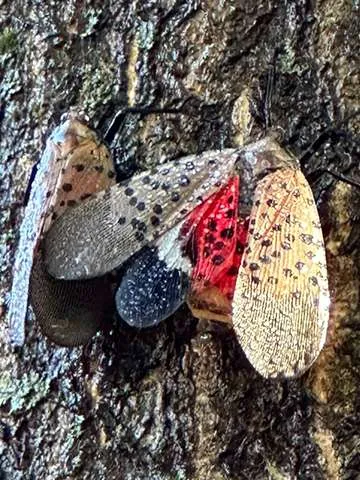Using Tree Pruning and Removal to Combat Spotted Lanternflies

The spotted lanternfly is an invasive insect that has quickly spread across New York City, inflicting considerable harm to trees and plants. This pest presents a major risk to local ecosystems, especially since it targets numerous tree species. As a homeowner or property manager, it’s important to take proactive measures to safeguard your trees from this destructive insect. Two of the most effective ways to manage spotted lanternflies are through tree pruning and, in more severe cases, tree removal. Understanding Spotted Lanternflies The spotted lanternfly (Lycorma delicatula) is native to Southeast Asia but has become a major pest in the United States, particularly in the Northeast. It feeds on tree and plant sap, which weakens the host and makes it more susceptible to disease. The insect’s feeding habits leave behind a sticky substance called honeydew, which promotes the growth of sooty mold. This black, sooty mold not only damages the tree but can also cover outdoor surfaces, making it a nuisance for homeowners. The spotted lanternfly has a one-year life cycle, with adults laying eggs in the fall. Egg masses are found on tree trunks, branches, and even man-made structures. The eggs hatch in the spring, and the nymphs begin feeding on a variety of plants before becoming adults in late summer. Pruning as a Preventative Measure Pruning plays a vital role in managing spotted lanternflies, particularly in the early stages of infestation. By removing infested branches, you can reduce the population of lanternflies on your property and slow the spread of the insect to other trees. Focus on pruning branches that show signs of infestation, such as oozing sap, sooty mold, or egg masses. Additionally, pruning helps improve air circulation within the tree’s canopy, which can make the environment less hospitable for the pests. Regular pruning also allows you to monitor the health of your trees more closely. By inspecting your trees during pruning, you can catch early signs of spotted lanternfly activity and take action before the infestation becomes severe. When Removal is Necessary In some cases, pruning alone may not be enough to control a spotted lanternfly infestation, especially if the tree is heavily infested or already weakened by the pest. Tree removal may be necessary to prevent the lanternflies from spreading to other healthy trees on your property or in the surrounding area. Tree removal is a last resort but is sometimes the only effective way to protect the rest of your landscape. When deciding whether to remove a tree, consider the extent of the infestation, the health of the tree, and its value to your property. A certified arborist from NYC Tree Pro can assess the situation and recommend the best course of action. Signs of Spotted Lanternfly Infestation Sooty mold on trees: This black mold is a sign of honeydew excreted by the lanternflies. Oozing sap: Look for sap oozing from small wounds in the tree bark, a common indicator of infestation. Egg masses on tree trunks: These are usually grayish and can be found on the bark, making them easy to spot during pruning. Presence of adult lanternflies: Adults are about an inch long, with long gray wings and black spots with bright red inside, and they often congregate in large numbers. Wilting or yellowing leaves: This can indicate that the tree is under stress from the feeding activity of the lanternflies. Comparison of Pruning vs. Removal for Spotted Lanternfly Control Method Best Used When Benefits Costs Drawbacks Pruning Early stages of infestation Preserves tree health Lower cost, typically $100-$500 May not be sufficient for severe cases Removal Severe infestation, tree decline Prevents further spread Higher cost, typically $500-$2000 Loss of tree, environmental impact Combined Approach Moderate infestation Balances health and control Moderate cost, depending on extent Requires ongoing monitoring Chemical Treatment When combined with pruning Targets lanternflies directly Varies, $100-$300 per application Environmental concerns, effectiveness varies Monitoring & Maintenance After initial treatment Prevents re-infestation Ongoing cost, typically $100-$300 annually Requires regular inspections
How to Trim a Mulberry Tree

Mulberry trees grow quickly and have beautiful foliage, and delicious fruit. To keep these trees thriving, regular pruning is essential. Whether your goal is to shape the tree, control its size, or enhance fruit production, proper pruning will ensure your tree remains healthy and productive. In this guide, we’ll take you step-by-step through the best methods for trimming a mulberry tree, including timing, techniques, and aftercare. Why Pruning Your Mulberry Tree is Important Pruning serves several critical purposes for mulberry trees: Promoting Tree Health: Pruning removes dead or diseased branches, which can reduce the risk of infections and encouraging healthy growth. Controlling Size: Mulberry trees grow quickly and can become quite large if left unchecked. Regular pruning keeps the tree at a manageable size for your garden or yard. Boosting Fruit Production: For fruit-bearing varieties, proper pruning ensures an abundance of accessible fruit. Shaping: In some cases, pruning is done for aesthetic reasons, such as maintaining a desired shape or form. When is the Best Time to Prune a Mulberry Tree? Major Pruning in Late Winter The best time for heavy pruning is during the tree’s dormant phase, typically in late winter, just before the new growth starts in the spring. Pruning during dormancy reduces sap loss and allows the tree to heal more efficiently. It’s also a good time to see the tree’s structure clearly without foliage obstructing your view. Light Pruning in Early Summer If your tree has excessive growth, you can perform some light pruning in early summer to maintain its size. Be cautious about cutting larger branches, though, as mulberries can struggle to heal these wounds during the active growing season. Beware of Sap Bleeding Mulberry trees are known to bleed sap from pruning wounds, especially if pruned outside of the dormant season. While sap bleeding isn’t harmful to the tree, it can be unsightly and may cause irritation if it gets on your skin. Essential Tools and Pruning Techniques Before you start pruning, make sure you have the right tools on hand: Tool Use Importance Best for Cost Pruning Shears Cutting small branches Ensures clean cuts to prevent damage Thin, young branches $20 – $40 Loppers Cutting thicker branches Necessary for larger branches Medium to large branches $30 – $60 Ladder Reaching higher branches Ensures safety and accessibility High branches and hard-to-reach areas $80 – $150 Gloves Protecting hands from cuts and sap Prevents injuries All types of branches $10 – $20 Safety Goggles Protecting eyes from debris Prevents eye injuries When cutting branches above the head $10 – $20 Hand Pruners: Best for small branches under 1 inch thick. Loppers: Ideal for branches that are 1-2 inches in diameter. Pruning Saw: For thicker branches that are over 2 inches in diameter. Sterilizing Agent: Always clean tools before and after pruning to prevent diseases from spreading between plants. Avoid Cutting Large Branches It’s best to avoid removing large branches (greater than 2 inches in diameter) as mulberry trees are slow to heal from large wounds, making them more susceptible to pests and infections. Step-by-Step Pruning Instructions Step 1: Remove Dead or Damaged Branches Begin by cutting away any branches that are dead, diseased, or damaged. This will enhance the tree’s overall health and reduce the risk of disease spreading. Make sure to cut back to healthy wood, leaving the branch collar intact to promote healing. Step 2: Remove Crossing and Inward-Growing Branches Branches that cross or grow inward towards the center of the tree should be pruned. These can crowd the tree, reduce airflow, and cause branches to rub against each other, which may lead to wounds and disease. Keep the canopy open to encourage better air circulation and sunlight exposure. Step 3: Shape the Tree for Light and Airflow When shaping the tree, focus on creating an open, vase-like structure with good spacing between branches. This allows light and air to reach the interior of the tree, which is especially important for fruit-bearing trees as it helps reduce the likelihood of disease and promotes even ripening of fruit. Step 4: Prune to Control Size If your tree is becoming too tall or wide, carefully trim back the larger branches to a manageable size. When pruning for fruit production, remember that mulberry trees bear fruit on last year’s growth, so be mindful not to over-prune and remove too many fruit-bearing branches. Advanced Pruning Techniques Pruning for Maximum Fruit Production Mulberries produce fruit on wood that grew the previous year, so pruning needs to be done carefully to preserve these branches. Here are some tips: Remove any dead or damaged wood first. Thin out branches to improve light penetration and air circulation. Lightly prune lateral branches, but ensure enough of the previous year’s growth remains to encourage fruit production. Consider creating a “harvesting notch” by pruning specific areas to make fruit more accessible. Pollarding for Shape Control Pollarding is a technique used to maintain a specific shape or control the height of your tree by regularly removing new growth back to the larger framework branches. This method should be started when the tree is young and requires consistent pruning to maintain. If done improperly, pollarding can weaken the tree and make it vulnerable to disease, so proceed with caution. Common Pruning Mistakes to Avoid Over-pruning: Taking off too much of the tree can reduce its vigor and fruit yield, particularly if you remove too much of last year’s growth. Topping: Avoid cutting the top of the tree, as this encourages weak regrowth and can damage the tree’s structure. Pruning Large Branches: Large cuts heal slowly and may leave the tree susceptible to pests and disease. Try to avoid pruning branches over 2 inches in diameter. Aftercare for Your Mulberry Tree Once you’ve finished pruning, your tree may need a bit of extra care: Monitor for Sap Bleeding: If you pruned outside of the dormant season, it’s normal to see some sap bleeding. This usually stops on its own, but monitor the tree to ensure the




